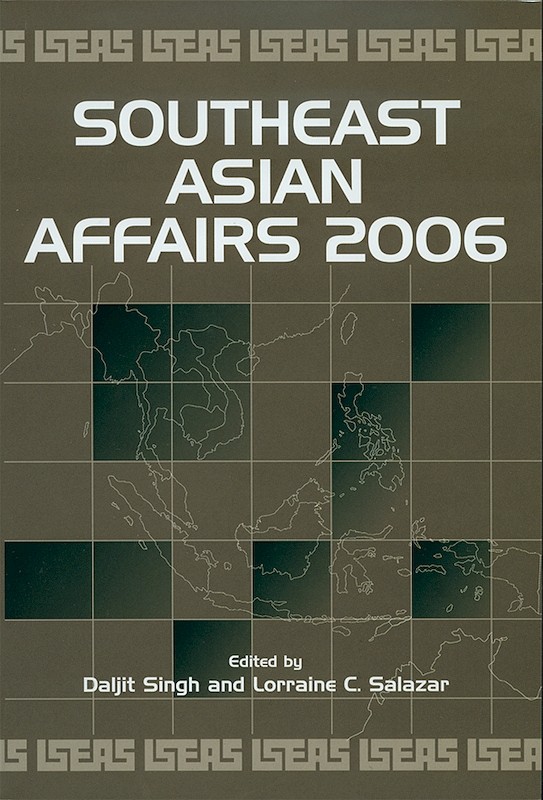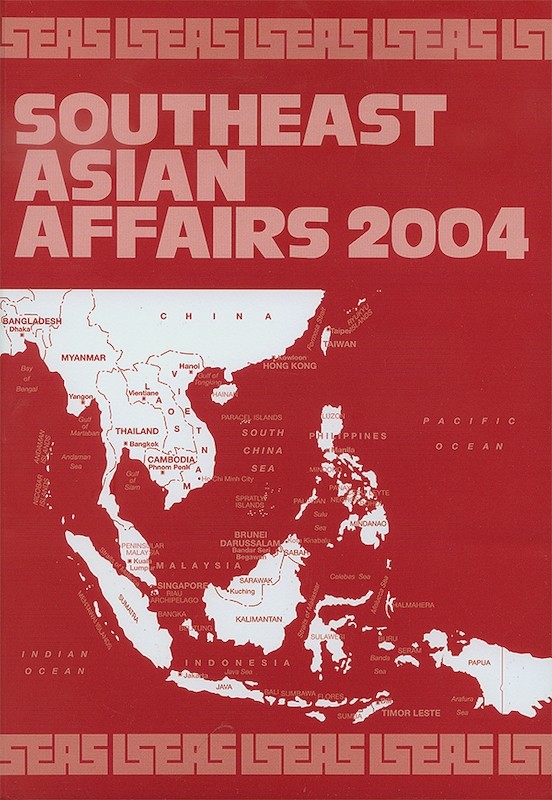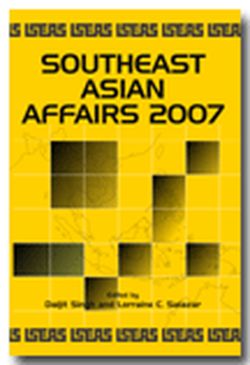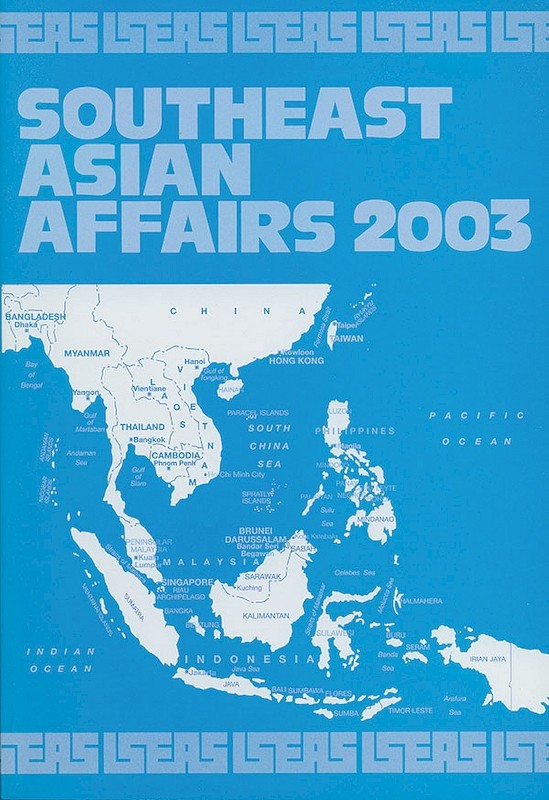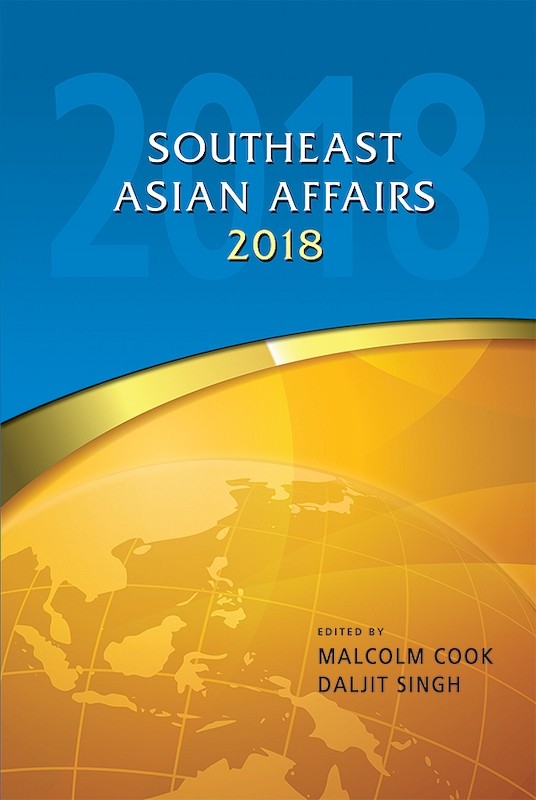Southeast Asian Affairs 2005
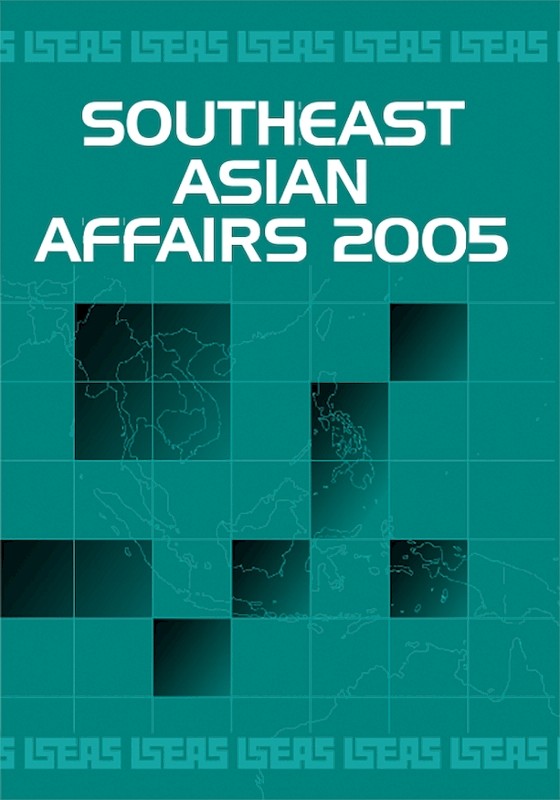
Date of publication:
2005
Number of pages:
421
Code:
SEAA5
Reviews
"Southeast Asian Affairs remains the most comprehensive annual review available that focuses squarely on Southeast Asia. It is particularly pleasing that this series has given space over the years to show-casing internationally the talents of leading scholars from Southeast Asia as well as scholars on Southeast Asia" (New Zealand International Review).
About the publication
Since its inception 30 years ago, Southeast Asian Affairs (SEAA) has been an indispensable annual reference for generations of policy-makers, scholars, analysts, journalists, and others. Succinctly written by regional and international experts, SEAA illuminates significant issues and events of the previous year in each of the 10 Southeast Asian nations and the region as a whole.
Contents
-
Southeast Asian Affairs 2005
-
Preliminary pages with Introduction
- THE REGION
-
Southeast Asia in 2004: Stable, but Facing Major Security Challenges, by Tim J Huxley, author see abstractDuring 2004, Southeast Asias political and security scene featured significant domestic developments in several of its states (notably Indonesia, Malaysia, Myanmar, the Philippines and Singapore), the continued salience of internal security challenges including a new outbreak of separatist-inspired violence in Thailands Muslim south as well as the threat from the pan-regional Jemaah Islamiyah (JI) network, the growing interest of extra-regional powers in the sub-regions security, and continuing efforts to make ASEAN a more useful vehicle for security cooperation. At the years end, the massive impact of the tsunami generated by the earthquake off Sumatra created humanitarian crises for Indonesia and Thailand, raising the question of whether governments in the region had paid sufficient practical attention to human security issues.
-
Political Transitions in Southeast Asia, by Mely Caballero-Anthony, author see abstractThis chapter examines the nature of political transitions taking place in the major capitals in Southeast Asia and reviews the prospects of democratic consolidation in the region. The analysis of transitions in this essay goes beyond the changes in governments resulting from the recent elections held across the region, to examine the greater salience of the new actors that have entered the political arena and how they may have altered the power configurations within these states and their impact on the nature of state-society relations. The chapter argues that while the mood for change has been indeed been upbeat and while hopes for greater democratisation may have heightened since the emergence of new political actors, the expectations for change may have to be tempered against the realities faced by these different states. These realities are reflected in the complex range of socio-economic, political and security issues faced by individual states that could hamper efforts at creating a more stable political system at the very least, and a politically liberal regional environment, at the most.
-
Southeast Asian Economies: Towards Recovery and Deeper Integration, by Denis Hew Wei-Yen, author see abstractDuring 2004, Southeast Asias political and security scene featured significant domestic developments in several of its states (notably Indonesia, Malaysia, Myanmar, the Philippines and Singapore), the continued salience of internal security challenges including a new outbreak of separatist-inspired violence in Thailands Muslim south as well as the threat from the pan-regional Jemaah Islamiyah (JI) network, the growing interest of extra-regional powers in the sub-regions security, and continuing efforts to make ASEAN a more useful vehicle for security cooperation. At the years end, the massive impact of the tsunami generated by the earthquake off Sumatra created humanitarian crises for Indonesia and Thailand, raising the question of whether governments in the region had paid sufficient practical attention to human security issues.
-
The Economic Impact of China and India on Southeast Asia, by Manu Bhaskaran, author see abstractSubstantial improvements in Chinas competitiveness and increasing signs that India is also emerging as a potential competitor to Southeast Asia have raised concerns over the regions longer term prospects. This chapter veers towards a more optimistic assessment of the regions chances of adjusting to increased competition from Asias two giants. It sees the region making important policy changes while its companies are engaged in re-engineering themselves. The net result is that Southeast Asia has held onto its share of global exports and is enjoying strong growth in its exports to China. It is consequently argued that, while competition for export markets and a share of global foreign direct investment flows will intensify as India makes strides in its supply side fundamentals, Southeast Asia will be able to hold its own so long as these adjustment processes continue.
-
Australia: Contributing to Regional Equilibrium, by Robyn Lim, author see abstractThis article discusses Australias foreign policy and security position vis a vis its Southeast Asian neighbours and in a wider geopolitical perspective. Dialogue through regional forums such as the ARF is not likely to settle such differences. Only a stable power equilibrium can contain them. Thus Australias approach to security in Southeast Asia will be to continue to do what it can on the basis of its own resources while looking to its alliance with the United States as the main means to achieve a balance of power conducive to Australias own interests. That policy is unlikely to change much whatever government holds power in Canberra.
- BRUNEI DARUSSALAM
-
Brunei Darussalam: Towards Reform and Sustainable Progress, by Azman Ahmad, author see abstractAbstract The year 2004 saw the reinstatement of the Legislative Council which had been suspended since 1984. The performance of the economy was lack-lustre in spite of the record oil prices, though the country continued to enjoy a high level of human development. Changes were underway in the educational system. The country took a new step in peacekeeping/monitoring operations by joining an international observer team to monitor the ceasefire in Mindanao.
- CAMBODIA
-
Hun Sen's Consolidation: Death or Beginning of Reform?, by Stephen R Heder, author see abstractCambodia in 2004 saw the dnouement not only of the national elections of July 2003 and subsequent political deadlock, but also of the decade of political transition since the departure of the United Nations Transitional Authority in Cambodia (UNTAC), and even of Cambodias political trajectory since the end of French colonialism. The UNTAC mandate over Cambodia and the years since have been analogous to 20th century contestations for control of post-colonial states in Southeast Asia. 2004 marked its end with the overwhelming victory of prime minister Hun Sen and his political and economic entourage, self-made men who emerged out of an apparatus created by Vietnamese Communists and the beginnings of market liberalisation in the late 1980s. Their decisive triumph involves a total co-optation of the FUNCINPEC Party and exclusion of the oppositionalist Sam Rainsy Party. Its decisive melding of bureaucratic, military and economic power is rooted in a sea change of socio-economic transformation driven by a self-regenerating, oligopolistic and predatory entrepreneurial elite.
- INDONESIA
-
Indonesia: The Year of a Democratic Election, by Leo Suryadinata, author see abstractThe 2004 election was the longest election that the country had ever witnessed. It marked a success in the Indonesias continuous quest for democracy as it was conducted in an orderly and peaceful manner. This chapter examines both parliamentary and presidential elections and their significance to Indonesian politics, the formation of the new cabinet and the problems faced by the new Yudhoyono administration. It also looks at the tsunami disaster and Indonesias foreign relations with special reference to the military relations between Indonesia and the US.
-
Indonesian Foreign Policy: A Wounded Phoenix, by Donald E Weatherbee, author see abstractDespite the hopes and expectations with the election of Indonesian President Yudhoyono, it was too early to speculate in 2004 on whether or not a new Indonesian foreign policy phoenix could launch itself into the ASEAN and East Asian international political atmosphere. The assertions of a resurrected leadership role for Indonesia are balanced by sober appraisals of Indonesian capabilities to lead in fact, pointing out resistance in ASEAN to Indonesian pretensions. This chapter presents the argument that, if Indonesia actively seeks to recapture the regional predominance attributed to Indonesia as the ASEAN primus inter pares in the Suharto era, it would be a wounded phoenix, lacking the capabilities of its Suharto predecessor, competing with other possible claimants to leadership, and in an international environment in which structures and institutions based on Southeast Asian political and economic exclusivity have an air of anachronistic irrelevance.
- LAOS
-
Laos in 2004. Towards Subregional Integration: 10 years on, by Vatthana Pholsena , author see abstractThe year 2004 marked the tenth anniversary of the opening of the first Lao-Thai Friendship Bridge between Vientiane and Nongkhai. In March, the first Thai-Lao joint cabinet retreat that took place in Pakse (southern Laos) marked the official start of the construction of the second Lao-Thai Friendship Bridge between the towns of Savannakhet and Mukdahan. On November, 29-30th, Laos successfully hosted for the first time the ASEAN annual summit in spite of attack threats and doubts cast over the country's capacity to organize such an event. While pursuing her economic regional integration, Laos has been facing international criticisms in regard to persistent vexing issues. Allegations by Amnesty International of the brutal killing of Hmong teenagers by a group of Lao soldiers have re-ignited serious concerns within the international community on the issue of human rights violations in Laos. Also on the international stage, the World Bank hosted an unprecedented series of public consultations between August and September in five capitals (Bangkok, Tokyo, Paris, Washington and Vientiane) over Laos' largest and highly controversial hydropower project, Nam Theun 2. A final decision is expected from the Bank by May 2005.
- MALAYSIA
-
Malaysia in 2004: Abdullah Badawi Defines his Leadership, by Patricia A Martinez, author see abstract2004 was very much Abdullah Ahmad Badawis year. In defining his leadership, he experienced the whole gamut from the triumph of being the reason for one of the most sweeping election wins in history for the ruling coalition to heeding the rumblings that had him say publicly at the end of the year that his honeymoon was over. Abdullah quickly forged his own course for the nation, but kept some fundamental dynamics in consonance with his predecessor, the man who steered Malaysia for 22 years.
-
Affirmative Action in Malaysia, by Lee Hock Guan, author see abstractOver the past thirty years, Malaysias ethnic preferential policies have undoubtedly helped to redress the under-representation of Malay participation in the Malaysian economy, especially in the urban/modern economic sector, and in tertiary education. The inequality gap between the Malays and Chinese has narrowed considerably and Malay equity ownership has reached more than 20 percent by 1990. A growing Malay professional middle class and corporate and business community have emerged. However, it is clear that the existing ethnic preferential policy has been inadequate in addressing the rising new phenomenon of intra-ethnic inequality for all ethnic groups, especially in the Malay community. This article assesses Malaysias ethnic preferential policy in the light of its successes and failures, and the need for the country to address new challenges to its economic, social and political fabric.
- MYANMAR
-
Myanmar in 2004: Why Military Rule Continues, by Kyaw Yin Hlaing, author see abstractAs 2004 came to an end, senior government officials publicly noted that the government would continue to rule the country without Khin Nyunt and his powerful intelligence apparatus who had been dramatically dismissed. Why is the junta in Myanmar still in power? Why did the tension between the intelligence and army units not lead to the break up of the regime? Both questions are addressed in this chapter by an examination of the internal structure of the Myanmar Tatmadaw (armed forces), and the juntas interaction with opposition parties, insurgent groups and other major societal actors. In order to fully understand the complex nature of the juntas continued rule in Myanmar, the author examines the internal dynamics of the opposition parties, exiled pro-democracy organizations, ethnic insurgent groups, and other societal forces that affect the juntas continued hold over the country.
-
Myanmar's Energy Sector: Banking on Natural Gas, by Tin Maung Maung Than, author see abstractCurrently, Myanmars energy officials and the local media are upbeat about the potential of a gas bonanza in Myanmars offshore waters. Expectations are high on accumulating huge amounts of foreign exchange earnings from exporting offshore natural gas that could finance Myanmars industrialization. Moreover, a series of ongoing and planned hydro-electric projects are also being touted as more than adequate to satisfy current and future needs thereby adding further impetus to its drive for industrialization and a higher standard of living for the people. Nevertheless, there still exist long-standing problems associated with supply shortfalls of fuels for industrial use, transportation and household consumption where substitutes for gasoline, diesel, fuel oil, firewood and charcoal are yet to be adequately provided. Fuel prices and electricity tariffs also need to be rationalized and must reflect capital and recurring expenditures. Whether Asian, especially India and PRC with its huge appetite for energy, could take up the slack in foreign direct investment and fulfil Myanmars aspirations to become a major regional player in gas exports remains unclear at the present.
- THE PHILIPPINES
-
The Philippines in 2004: A Gathering Storm, by Benjamin N Muego, author see abstractWith double-digit unemployment, heavy domestic and foreign borrowings, massive budget deficits, nascent capital flight, rampant corruption and a restive military, among other things, the next few months will be crucial in determining the future of the Macapagal-Arroyo government. While arguably, opposition to Gloria Macapagal-Arroyo personally and her unpopular regime generally, has yet to reach critical mass, all the tell-tale signs seem to suggest that unless drastic steps are taken to address the countrys serious short- and long-term problems, the country might well be plunged into another major political upheaval reminiscent of the people power revolts of 1986 and 2001 that toppled the Marcos and Estrada regimes, respectively. The survival or early demise of the Macapagal-Arroyo government is contingent on her ability to rein in the countrys corrupt oligarchs and political dynasties whose support and financial backing played a pivotal role in her putative election victory over the late Fernando Poe, Jr. in May of last year. Also crucial to the Macapagal-Arroyo regimes survival is the continued support of: (1) the leadership and rank and file of the Armed Forces of the Philippines and the Philippine National Police; (2 the Catholic Church and other politically-monolithic religious organizations like the Iglesia ni Kristo and El Shaddai; and, (3) official Washington, D.C. and the United States.
-
The Philippines: The Continuing Story of a Crisis-Prone Economy, by Cielito F Habito, author see abstractBeing an election year, it was commonly expected that the Philippine economy would grow faster in 2004 compared to the year before. In fact, the expectation was more than realized. Not only did actual economic growth as measured by growth in gross domestic production (GDP) exceed that of 2003, it also went beyond the targets set by the government for the year. Moreover, the economys growth compared favourably with that of most of its neighbours in the region. But GDP growth was only one yardstick for the economy. The current economic picture for the Philippines is a mixed, even confused one. On one hand, there is good news in the behaviour of the equity and currency markets, inviting the tempting interpretation that these are precursors of better times ahead. But an understanding of the underlying weaknesses still plaguing the Philippine economy dictates a more prudent outlook. There is a great deal of uncertainty as to how long the bullish sentiment would last. Seasoned observers of the Philippine economy know well enough to understand that the tides can shift very quickly in this vibrant and highly politicized society.
- SINGAPORE
-
Singapore in 2004: Vigilance amid Growing Uncertainty, by Teo Kah Beng, author see abstractThe strategic uncertainty in the post-911 world appears to have vindicated Singapores policy of vigilance. Although more prosperous, Singapores realist mindset has not changed. Singapores friendship with all policy seeks to ensure that its economy stays internationally competitive. In August 2004, Singapore saw its second, orderly political succession. PM Lee Hsien Loong promised to build a more open and inclusive society. Parliamentary elections, expected in 2005, will be significant in showing the extent of his popularity. The economy grew by a robust 8.4%, compared with 1.1% in 2003. As Singapore seeks to become a global financial hub, observers have become more critical about its corporate governance. Singapore used its FTA strategy to increase its economic space. Good relations were restored with Malaysia and Indonesia. Singapore actively engages a rising China, while enhancing its already excellent ties with the US. Singapore is determined to perpetuate its exceptionalism.
-
Singapore's Approach to Homeland Security, by Andrew T H Tan, author see abstractSingapores response to the war on international terrorism has been the most vigorous of the Southeast Asian states. Like the U.S., it has taken homeland security very seriously, and has instituted as a top national priority, the implementation of a new homeland security architecture that would better protect Singapore against terrorism. In August 2004, the government formally outlined Singapores National Security Strategy primarily aimed at countering the terrorist threat. Acute awareness of its small size, limited resources and geopolitical circumstances has resulted in Singapore developing what amounts to outsiders as a siege mentality. Singapore has adopted an all citizens to the ramparts approach, embodied in its doctrine of Total Defence, which not only maximizes the resources for defence but also emphasizes the importance of military deterrence, economic strength, and internal cohesion and stability as the foundations of its security
- THAILAND
-
Thailand: The Facts and F(r)ictions of Ruling, by Michael Kelly Connors, author see abstractThe year 2004 was marked by the ordinary and the extraordinary. Of the former, the normal shenanigans of Thai politicians receive the most coverage in this chapter. The ruling party Thai Rak Thai attempted to lure coalition and opposition MPs into its ranks with varying levels of success. Seven years after the passing of the 1997 reform constitution, Thai parliamentary politics looked remarkably familiar, with one exception the strangle hold that Thaksin had over the legislature. However, Thaksin did not have it all his own way. A series of surprising developments put pressure on his administration, and suggest that elite opposition to Thaksin is cohering. Economically, the economy continued to grow, as did liberal criticisms of Thaksins economic policies. Of the extraordinary, Thailand was rocked by the rise of political violence in the Muslim majority provinces in the South. Claims and counter-claims make it difficult to identify the catalyst of this upsurge in violence. The south faced further tragedy with the tsunami that struck in late December.
-
Thailand's Paradoxical Recovery, by Peter Warr, author see abstractThailand has recovered well from the crisis, despite unexpected setbacks including rural drought, Asian influenza, SARS, political violence in the South and most recently, the terrible tsunami of 26 December 2004. The government of Thaksin Shinawatra has done much to restore confidence and was rewarded by a massive electoral victory in February 2005. The paradox is that the recovery is quite different from the economic outcome was promised and seemingly planned, both in its rate and its composition. The long-term economic future seems good, provided issues of long-term reform are addressed. The country's archaic education system must be the most important of these and the promotion of competition within the domestic economy must be the second. Given its enormous parliamentary majority in its second term and the Prime Minister's own popularity, Thaksin's Thai Rak Thai government has a unique opportunity to address fundamental issues of reform.
- VIETNAM
-
Vietnam in 2004: A Country Hanging in the Balance, by Michael J Montesano, author see abstractDuring 2004 Vietnam confronted its corruption problem with unprecedented apparent seriousness. Its National Assembly assumed greater importance in the governmental arena. As the country began to look toward the Tenth Party Congress of the Communist Party of Vietnam in early 2006, tensions in the Central Highlands escalated into violence. Despite a healthy economic performance, critics voiced concern that Vietnam failed to live up to its potential or to meet the challenges of international competition. The pace and terms of both Vietnam's accession to the World Trade Organization and its equitization of state-owned enterprises remained uncertain. Success in hosting the Fifth Asia-Europe Meeting in Hanoi came in the context of criticism of Vietnam's human-rights record, low-level tensions in the South China Sea, enhanced military-to-military ties with the United States, and a focus on Northeast Asian affairs. The period leading up to the Party Congress will see Vietnam face important decisions about its future.

